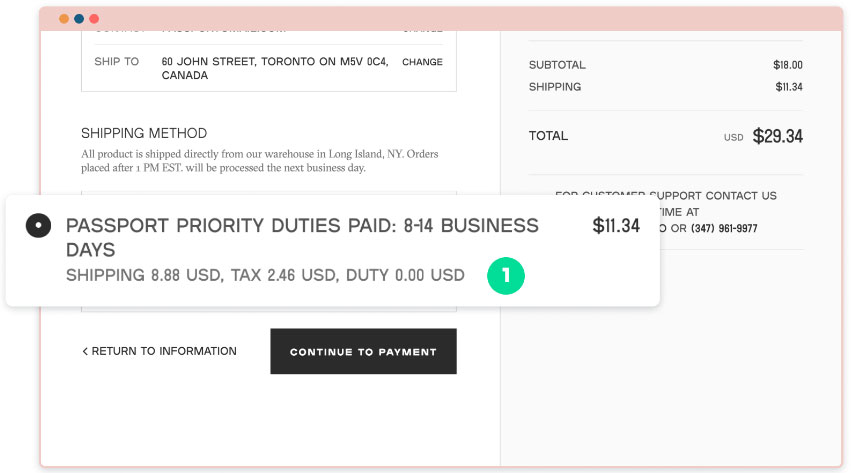Exploring the global e-commerce treasure trove
The global e-commerce market is a vast and lucrative market, estimated to be worth $6.3 trillion in 2024. This large market offers unparalleled growth opportunities for companies looking to expand their horizons. As the total value of the global e-commerce industry continues to rise to he $8 trillion by 2027, now is the time for brands to take advantage of the immense potential that extends beyond national borders.
Expanding internationally opens the door to the unique advantage of lower customer acquisition costs (CAC) compared to the domestic market. Brands may face challenges adapting to different cultural norms, but the potential for higher average order value (AOV) often outweighs the initial investment.
However, not all brands can enter the global e-commerce space due to various challenges. Issues such as creating localized experiences, meeting compliance regulations, and investing in customer experience (CX) can hinder companies from expanding into international markets. Brands that proactively address these challenges by deploying localized strategies and focusing on the delivery experience will capture the lion's share of shoppers in the global e-commerce market.
5 localization methods that work quickly
In the dynamic landscape of global e-commerce, unlocking the potential of international markets requires a nuanced, market-specific approach. By adopting these five localization and distribution experience methods, companies can overcome the complexities of selling products internationally and pave the way to sustained global success.
1. Improve searchability with SEO localization
That journey begins by making your brand and products easily discoverable by international customers. Standard search engine optimization (SEO) techniques may not be effective in a diverse market with different search habits and languages.
It's essential to prioritize SEO localization by optimizing your website's content, metadata, and keywords for each target market's language and search trends. Conduct thorough keyword research in local languages and strategically incorporate them into your content.
Creating region-specific landing pages and localized URLs further improves search visibility and drives organic traffic from users around the world. Remember that search engines like Google aim to show you the best results for your queries. Therefore, localized websites with personalized language, currency, and content relevance play a vital role in achieving this goal.
2. Local storefront optimization
Providing a localized website experience is key to attracting international consumers and driving conversions. Statistics show that sites that localize currency on their product pages see a 40% increase in conversion rates.
Currency, language, and imagery should be tailored to local aesthetics and cultural norms. Additionally, featuring region-specific product recommendations, testimonials, and reviews makes your site more relevant and trustworthy to international visitors.
We use geolocation technology to automatically redirect visitors based on their location, improving the user experience and streamlining the purchasing process. Brands that offer region-specific products based on factors such as seasonality, regional holidays, and product popularity often report much higher order conversion rates.
3. Price localization and testing
A comprehensive pricing localization strategy is needed to address additional costs and unexpected fees, which are the number one reason for shopping cart abandonment. This involves more than just converting currencies. Pricing strategies must be adjusted to reflect local market dynamics, purchasing power, and consumer preferences. Conducting thorough market research is important to assess cost sensitivity and identify competitive benchmarks for each region.
Implement a dynamic pricing strategy that adjusts based on demand, competition, and currency fluctuations. By testing tariffs and tax-inclusive prices, you can further align your products with local expectations.

Additionally, offering region-specific discounts, promotions, and loyalty programs, especially those that align with local holidays, drives purchases and increases customer engagement. Combining these approaches not only maximizes your profits but also strengthens your position in international markets.
4. Providing local delivery options
77% of online shoppers have given up on purchasing online because they are not satisfied with the delivery options. This means it's important to ensure pricing, including up-front taxes and duties, is clear and transparent to avoid unexpected surprises and cart abandonment due to hidden costs. .
We also simplify the purchasing process and remove barriers to purchase by offering convenient payments and multiple shipping options such as Economy, Priority, and Express.
5. Branded and localized tracking experience
Real-time order tracking is a game-changer, with 87% of shoppers finding that real-time order tracking makes their buying experience more enjoyable. The customer experience extends beyond his website. Branded shipping boxes, email communication, tracking pages, and responsive customer service allow consumers to return and shop again with peace of mind and confidence.
![]()
Providing personalized and responsive customer support is essential to building trust and loyalty among consumers around the world. Engaging with them on social media platforms and forums in their native language can help create a sense of community and strengthen their connection with your brand.
Seize global opportunities through managed support
Mastering global markets requires careful attention to localization. However, as companies embark on global expansion, the need for comprehensive solutions and hands-on support from knowledgeable international experts becomes clear.
The complexity of developing regional growth strategies, managing shipping and compliance hurdles, and more can slow your brand's growth. That's why many brands look to providers to help them navigate the complexities of international commerce.
Passport Global™ is an all-in-one global transportation and internationalization solution designed to simplify and accelerate the process of international expansion.
This turnkey solution provides in-house logistics and compliance services, complete visibility into performance data, localized growth strategies and store conversion testing, and direct order payments to reduce cash flow delays. We provide two-end support and enable brands to scale up quickly. their international trade;

Unleash the power of localized global e-commerce
The global e-commerce market offers endless opportunities for companies ready to embrace international expansion. By addressing challenges through localized experiences, compliance, and strategic CX investments, brands can unlock the potential for lower CAC and higher AOV.
By following five key steps, including SEO localization, in-store optimization, pricing strategy, shipping methods, and brand tracking experience, you'll be set up for success with your global e-commerce efforts.
With Passport Global as an easy all-in solution, your efforts to rapidly grow your global sales are not only imaginable, but easy to achieve. Embrace global markets, localize effectively, and watch your business thrive on the international stage.
About passports
Founded in 2017, Passport® is an international solutions provider that helps brands easily expand globally. With internationalization technology, in-house shipping and compliance services, and expertise in helping brands grow profitably, Passport has enabled his more than 1,000 merchants of all sizes to seamlessly access markets around the world. Ta. To learn more about our company, services and careers, please visit passportshipping.com.


